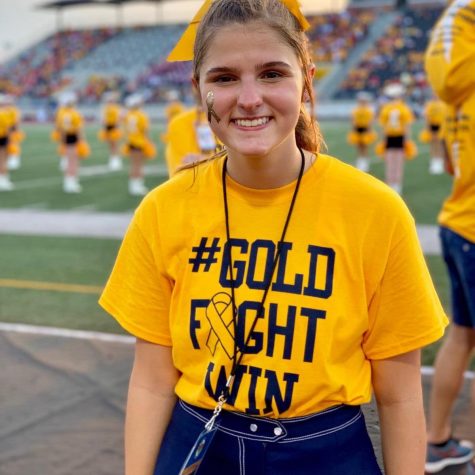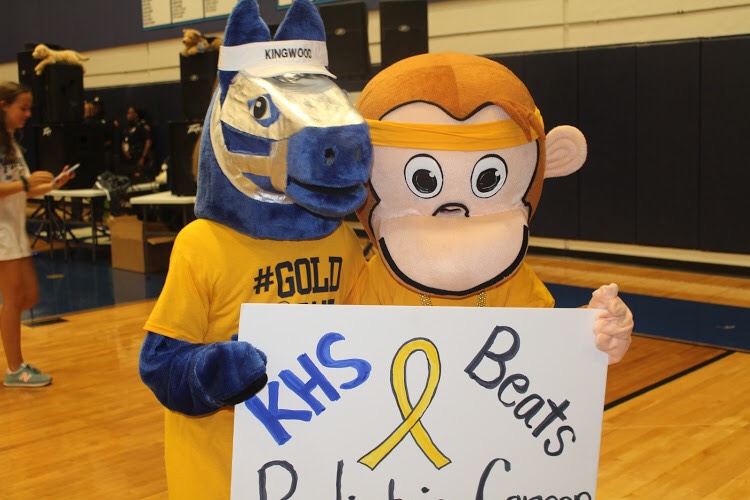What Does “Go Gold” Mean?
September is Pediatric Cancer Awareness Month, and it is important to reflect on the impact of "going gold" and supporting awareness and research.
September 22, 2019
Photo Cred: Braden Hopkins; KHS Mascot and Addi’s Faith Mascot at our Go Gold Pep Rally
For the past month, “Go Gold!” and “Gold, Fight, Win!” and flurries of gold t-shirts and merchandise have filled the Kingwood High School campus and schools across the country for Pediatric Cancer Awareness Month. At KHS, we had Gold Out sports games, events, and a pep rally, and many students participated in these events with great enthusiasm and decked out in gold. In the Kingwood community, fundraisers for pediatric cancer research have been in full swing, and many students and families donated to organizations such as Addi’s Faith Foundation and the L3 Foundation. It truly is incredible to see people supporting pediatric cancer research; however, people are not always aware of how impactful their support can be.
This past summer, I received the opportunity to intern in the lab of Dr. Vidya Gopalakrishnan, Ph. D, at MD Anderson Cancer Center. Until then, I had heard about pediatric cancer research but had never understood exactly what such research entailed, nor had I ever encountered the dedication of researchers working toward a cure. Throughout my time in the lab, every scientist I met worked with a determination that I had never seen before, thinking critically and experimenting at a tenacious level while always pushing forward to a common long-term goal: finding the solutions they searched for, finding answers, finding effective treatments, finding a cure. What made the deepest impression on me as summer came to a close was that these researchers do not work in this manner merely because they love science. They work and persevere because they fight for bettering the lives of patients. Labs like this one are where many generous and kind grants and gifts go, funding the resources, materials, and technology to continue onward with experiments, discoveries, and ultimately treatment options for pediatric cancer patients.
Dr. Gopalakrishnan’s lab conducts research within the Pediatrics Department of MD Anderson.
“Our lab focuses on understanding how and why children develop brain tumors. We use this information to develop personalized and immune-based treatment approaches.”
Specifically, I was able to observe tests being conducted on various cultures of Diffuse Intrinsic Pontine Glioma (DIPG) cells, which are brain tumor cells that form in the brain stem. This type of tumor is already aggressive and harmful, but in young children, treatment options for tumors in the brain stem are severely limited because their brains are still rapidly developing. According to Dr. Gopalakrishnan, “We still know very little about pediatric cancers. They are very different from cancers in adults. Therefore, treatments that adults receive may not necessarily work for children.” Because of this, her lab works to develop “immune-based treatment approaches” in order to avoid operation or radiation that could potentially harm a young child’s brain immensely. By testing DIPG cells for various protein expressions, the lab seeks outlets to develop a drug to treat against proteins that allow DIPG tumors to grow.

Kingwood High School junior Laine Raley is a survivor of childhood leukemia and “was enrolled in a trial treatment where [she] received two additional chemos than the average patient.” As a result, she is “monitored yearly because of the drugs and will have to be monitored for the rest of [her] life. The side effects can be long term and show up later in life. It could affect any of [her] organs, and some of the chemo did affect [her] cognitive thinking (which is why [she’s] had to have tutoring since second grade).” Laine is incredibly strong, and her life is so valuable. Anyone who knows Laine knows that she brings joy, love, and kindness to every single person she meets.
When asked why she feels it is important for people to understand the impacts of pediatric cancer, Laine responded:
“First of all, there are several different forms of cancer which allows each one to have a different story. The survival rates vary and not all cancers are curable. I was one of the lucky ones. My cancer has three different types. Working in each type, there are three different levels of risk. Mine was in the middle. My survival rate was set at 85% with the two additional chemos, meaning I took 14 chemos over 2.5 years. Within the first 6 months of treatment, my parents attended 16 funerals for other children who weren’t as lucky as me.”
The majority of research in any field goes on behind the scenes, and the steps taken to reach the end result are not always recognized. Without conducting research and thousands of tests, Thomas Edison would not have been able to generate the working lightbulb. Without research, comprehensive investigation, and hundreds of tests, Edward Jenner would not have been able to develop the very first vaccine. Without research and running numerous tests for confirmation, Alexander Fleming would not have been able to create penicillin. Without research, Wilhelm Röntgen would not have been able to pioneer radiation therapy for cancerous tumors. Without research, the breakthroughs, discoveries, treatments, and recoveries that occur in hospitals across the world would not be possible.
When talking to Mrs. Amber Bender, who lost her precious daughter Addi to cancer, she had an amazing perspective to share as she leads the efforts of funding research and caring for families through the Addi’s Faith Foundation.
“To this day, researchers continue to use Addi’s tumor cells as they explore new possibilities for treating pediatric brain tumors. Because of her, this vital research continues in a lab that Addi’s Faith Foundation is helping to fund. That’s pretty special. There is a plethora of approaches and novel ideas out there that just need funding so we can further investigate. With less than 4% of the NCI budget going to pediatric research it is vital that organizations like ours, and people like you, step up to fund research and accelerate progress.”
The scientists in these labs work tirelessly and passionately all day and as long as necessary to run as many tests or make as much progress possible in the span of several hours. Eventually, as experiments progress, research done at the lab bench evolves into clinical trials, and if successful, this research ultimately becomes new treatments that can save lives. To Dr. Gopalakrishnan, “the most impactful aspect of [her] job is to drive bench research to the clinic.” Medical progress happens every single day. It is of utmost importance that we continue to ensure that it can happen and that pediatric cancer research can move forward and upward, and that hopefully more lives can be preserved each day.

